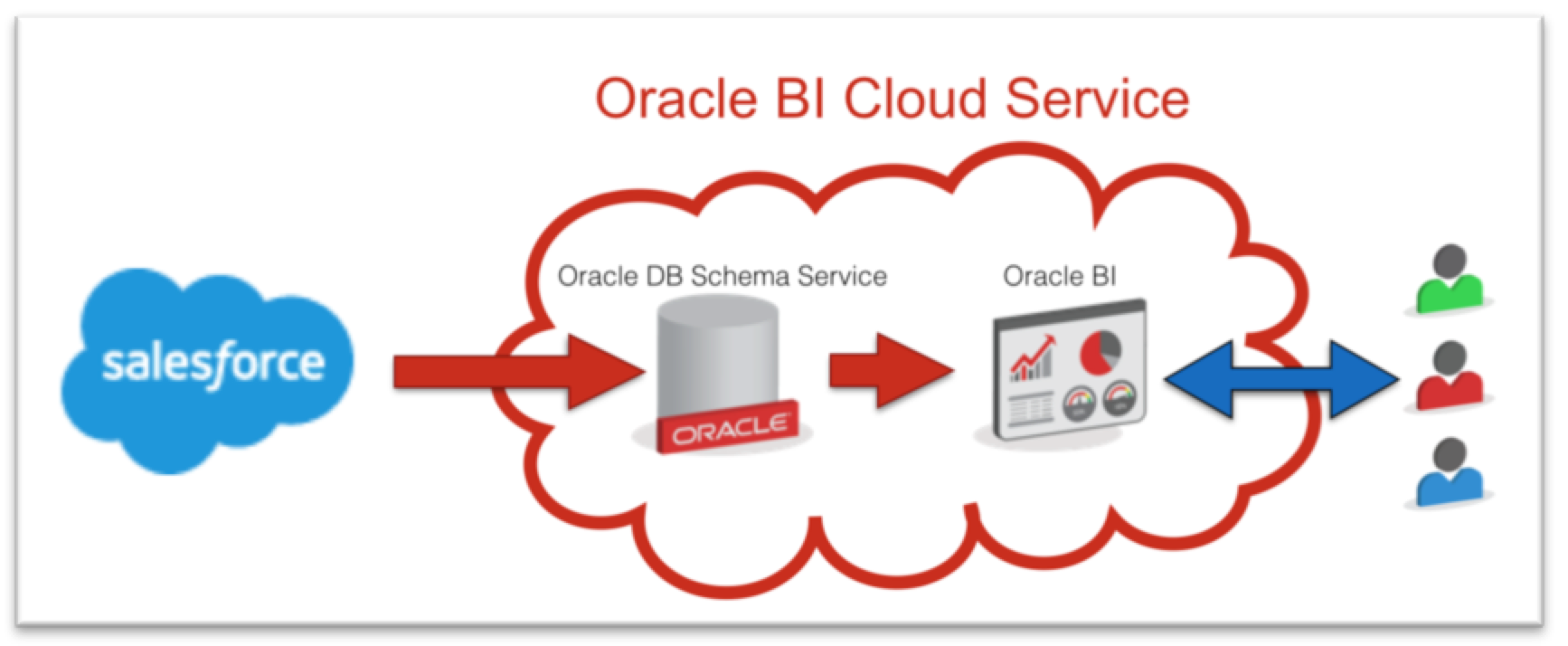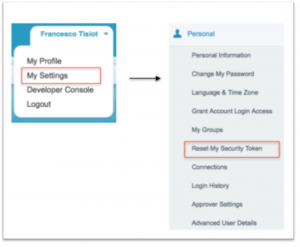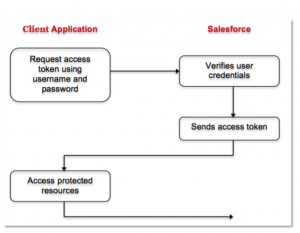Oracle BI Cloud Service for SaaS Application Reporting Part 1: Integrating BICS to Salesforce.com using REST APIs
Last month Mark Rittman covered a series of posts detailing the Oracle BI Cloud Service (BICS), aimed at departmental users who want the power of OBIEE 11g without the need to stand-up their own infrastructure. If you’re coming in late, here’s the link to the series.
Before the GA Rittman Mead participated in the beta program for release one of Oracle’s Business Intelligence Cloud Service (BICS), the global aim of the beta was both to understand the capabilities and to identify potential use cases of the new BICS platform. As Mark wrote, an excellent use case for BICS is to report on top of any SaaS application that expose the data (stored in the cloud) using REST APIs by taking advantage of the ApEx capabilities hosted in the Database Schema Service that comes with BICS. SaaS applications like Oracle's Fusion CRM, Taleo or Salesforce.com - that was used during the beta program - can be easily integrated and queried with BICS.
The technical goal of our beta program has been to check the features, options and limitations of Oracle BICS by connecting it to a Salesforce.com instance, accessing the data exposed through REST APIs by using the ApEx native functions, storing the data in the Database Schema Service, creating the Repository using the new Model Editor and showing the data in dashboard by keeping the same data security settings configured in the source platform.

This series of post is going to explain all the details about our successful PoC, over the next few days we’ll be covering the following topics, and we’ll update the list with hyperlinks once the articles are published:
- Oracle BI Cloud Service for SaaS Application Reporting Part 1: Integrating BICS to Salesforce.com using REST APIs
- Oracle BI Cloud Service for SaaS Application Reporting Part 2: BICS ApEx components
- Oracle BI Cloud Service for SaaS Application Reporting Part 3: BICS Repository and Front-end configurations
In the first post of the series we're going to define the steps required to setup a Salesforce.com demo environment that can be accessed with REST APIs. Later in the post we intend to analyse the most interesting Salesforce.com REST APIs that are used to extract the data from the platform. Before starting digging into the BICS-Salesforce.com integration, some definitions may be needed:
- RESTful APIs: A Web service API can be defined as RESTful if it conforms to the REST architectural constraints. Some more details about RESTful APIs can be found here.
- Salesforce.com: Salesforce.com is company specialised in software as a service (SaaS) and one of the major providers of CRM in the cloud. In addition to CRM Salesforce.com offers Force.com a cloud platform as a service (PaaS) that developers can use in order to build multitenant applications hosted on Salesforce.com servers. All the Force.com applications can be accessed by using RESTful APIs.
Environments Setup
In a new BI project it is never safe to directly extract data from a live (production) environment. Thus the first step needed in order to test BICS-Salesforce.com connection is to obtain a Salesforce.com environment that we can use without the risk of slowing it down, or even worse crashing and impacting users. A free demo Salesforce.com platform can be obtained by subscribing for the developers program and can be customised as needed. After requesting the Salesforce.com demo environment the creation of a security token is needed, the token is associated with the user invoking the RESTful API. To generate the token: login to Salesforce.com with the specific user -> click on the username -> My Settings -> Reset My Security Token. The new token should then be sent to the user's email.

The third step in order to access Salesforce.com data with REST APIs is to define a Connected App. The creation of a Connected App generates a Consumer Key and a Consumer Secret that is going to be used later during the REST login calls. Once defined a Connected App, the last bit missing is to populate the Salesforce.com instance since it's empty by default, it can be populated manually or by writing population scripts based on the create REST API statements explained here. An Oracle BICS instance is needed in order to analyse the Salesforce.com data, all the info regarding Oracle BICS and how to activate one instance can be found at this link. Having covered all the basics, it's time to start analysing how the Salesforce.com data can be extracted.
Salesforce.com REST APIs
In the following sections we are going to analyse some of the REST APIs used in our process. The Salesforce.com REST APIs will be called with cURL commands, cURL is a command line tool and library for transferring data with URL syntax.
Salesforce.com Authentication
The first step in order to download the data from any Salesforce.com instance is to execute the authentication and retrieve the access token, the access token will then be used in all the following REST calls. There are various authentication mechanisms that can be used against Salesforce.com, for the aim of the beta program we used the one called "Username-Password OAuth Authentication Flow" that is described in detail here and in the image below.

The REST API authentication command is
curl -v https://login.salesforce.com/services/oauth2/token -d "grant_type=password" \
-d "client_id=CLIENT_ID" -d "client_secret=CLIENT_SECRET" \
-d "username=USERNAME" -d "password=PASSWORD_TOKEN"
where the following parameters must be assigned:
- CLIENT_ID: The client ID generated during the creation of the Connected App (step described in Basic Setup)
- CLIENT_SECRET: The client Secret generated during the creation of the Connected App (step described in Basic Setup)
- USERNAME: The username you want to use in order to access Salesforce.com data
- PASSWORD_TOKEN: The concatenation of password and user security token (e.g. if the password is ABC and the security token is 123 then PASSWORD_TOKEN is ABC123)
The response (if all the parameters are correct) should be like the following
{
"id":"https://login.salesforce.com/id/00Dx0000000BV7z/005x00000012Q9P",
"issued_at":"1278448832702",
"instance_url":"https://na1.salesforce.com",
"signature":"0CmxinZir53Yex7nE0TD+zMpvIWYGb/bdJh6XfOH6EQ=",
"access_token":"00Dx0000000BV7z!AR8AQAxo9UfVkh8AlV0Gomt9Czx9LjHnSSpwBMmbRcgKFmxOtvxjTrKW19ye6PE3Ds1eQz3z8jr3W7_VbWmEu4Q8TVGSTHxs"
}
where the most interesting parameters are:
- instance_url: defines the salesforce instance to use.
- access_token: defines the time-limited security token to use for all the following calls.
Salesforce.com List of Objects and Retrieve Metadata for an Object
Two of the Salesforce.com REST APIs were very useful when trying to build a general ETL that could be applied to any customised Salesforce.com instance:
- Get list of Objects: retrieves the list of all objects available in Salesforce.com (custom or not) with some additional information for each object.
- Retrieve Metadata for an Object: retrieves the list of columns for the selected object with related data types and additional information.
The Get list of Objects call is the following
curl INSTANCE/services/data/VERSION/sobjects/ -H "Authorization: Bearer TOKEN"
where
- INSTANCE is the instance_url parameter retrieved from the authentication call.
- TOKEN is the access_token parameter retrieved from the authentication call.
- VERSION is the REST APIs version used, in our beta test we used v29.0.
The response should be similar to the following in which you could see for each object (identified by the "name" field) all the metadata available.
{
"encoding":"UTF-8",
"maxBatchSize":200,
"sobjects":[
{
"name":"Account",
"label":"Account",
"keyPrefix":"001",
"labelPlural":"Accounts",
"custom":false,
"layoutable":true,
"activateable":false,
"urls":{
"sobject":"/services/data/v26.0/sobjects/Account",
"describe":"/services/data/v26.0/sobjects/Account/describe",
"rowTemplate":"/services/data/v26.0/sobjects/Account/{ID}"
},
"searchable":true,
"updateable":true,
"createable":true,
"deprecatedAndHidden":false,
"customSetting":false,
"deletable":true,
"feedEnabled":true,
"mergeable":true,
"queryable":true,
"replicateable":true,
"retrieveable":true,
"undeletable":true,
"triggerable":true
},
...
]
}
The Retrieve Metadata of an Object can be called for each object listed in Get list of Object response, the code is the following:
curl INSTANCE/services/data/VERSION/sobjects/OBJECT/ \
-H "Authorization: Bearer TOKEN"
where:
- INSTANCE and TOKEN and VERSION are the same parameters defined for Get list of objects call
- OBJECT is the Salesforce.com object to retrieve
The response for the Account object is similar to the following
{
"objectDescribe":{
"name":"Account",
"updateable":true,
"label":"Account",
"keyPrefix":"001",
...
"replicateable":true,
"retrieveable":true,
"undeletable":true,
"triggerable":true
},
"recentItems":[
{
"attributes":{
"type":"Account",
"url":"/services/data/v20.0/sobjects/Account/001D000000INjVeIAL"
},
"Id":"001D000000INjVeIAL",
"Name":"asdasdasd"
},
...
]
}
Interesting parameters for each column are:
- name: is the columns name.
- retrievable: if true it means that the particular column can be part of a query
- soapType and length or byteLength: these fields provide the field type information and the length of the field.
With the three REST APIs analysed we could recreate all the objects (custom or not) in any Salesforce.com (or Force.com) instance as tables in the Oracle Database Schema Service. In the next section we will see how to extract the data from the list of objects by using the Salesforce.com query capabilities.
Salesforce.com query
Salesforce provides two methods of querying the objects: including or excluding deleted object. The difference in the code is minimal, the first uses the /queryAll suffix while the second uses the /query. A Salesforce.com REST API query call is:
curl INSTANCE/services/data/VERSION/query/?q=SELECT+LIST_OF_COLUMNS+from+OBJECT \
-H "Authorization: Bearer TOKEN"
where:
- INSTANCE and TOKEN parameters are the ones retrieved from the Authentication call
- VERSION is the Salesforce.com REST API version used
- OBJECT is the Salesforce.com object to query
- LIST_OF_COLUMNS is the comma delimited list of columns to retrieve
The response of a query "select+Name+from+Account" is:
{
"done":true,
"totalSize":14,
"records":[
{
"attributes":{
"type":"Account",
"url":"/services/data/v20.0/sobjects/Account/001D000000IRFmaIAH"
},
"Name":"Test 1"
},
{
"attributes":{
"type":"Account",
"url":"/services/data/v20.0/sobjects/Account/001D000000IomazIAB"
},
"Name":"Test 2"
},
...
]
}
In the JSON result you can find:
- totalsize: the number of records retrieved
- Name: for each record the name of the Account
If the resultSet is too big, Salesforce.com will start paging results. If the initial query returns only part of the results, the end of the response will contain a field called nextRecordsUrl. For example:
"nextRecordsUrl" : "/services/data/v20.0/query/01gD0000002HU6KIAW-2000"
In order to get the next page of data a call like the following is needed passing the access token as a parameter.
curl INSTANCE/services/data/v20.0/query/01gD0000002HU6KIAW-2000 \
-H "Authorization: Bearer TOKEN"
Salesforce.com limits
It's important to be aware of the limit set by Salesforce.com on the number of REST API calls per day. In order to check at any time the remaining number of calls available execute the following code.
curl INSTANCE/services/data/VERSION/limits/ -H "Authorization: Bearer TOKEN "X-PrettyPrint:1"
The DailyApiRequest -> Remaining field contained in the response shows the amount of calls still available.
{
"DailyApiRequests":
{
"Remaining":"4980",
"Max":"5000"
},
"DailyAsyncApexExecutions":
{
"Remaining":"250000",
"Max":"250000"
},
...
}
Resultset output format
Salesforce.com default output format is JSON, which is a common format for most of the cloud application. However there is the opportunity to also retrieve the result in XML format by using the HTTP ACCEPT header set to "application/xml". This first release of the tool is based on Oracle DB11g which supports native XML and not JSON. For this reason during our beta program with Oracle BI Cloud Service we decided to use the XML output. Once BICS will be bundled with the Oracle DB 12c that supports JSON and XML native, the resultset output format could be kept as default in JSON. In this post we defined the steps required in order to setup a Salesforce.com demo environment that can be accessed with REST APIs and which are the most interesting Salesforce.com REST APIs that we used to extract the data in order to analyse it with Oracle BI Cloud Service platform. In the next post we will look more in detail at the BICS ApEx part of it by analysing how the Salesforce.com REST APIs can be called from ApEx.
